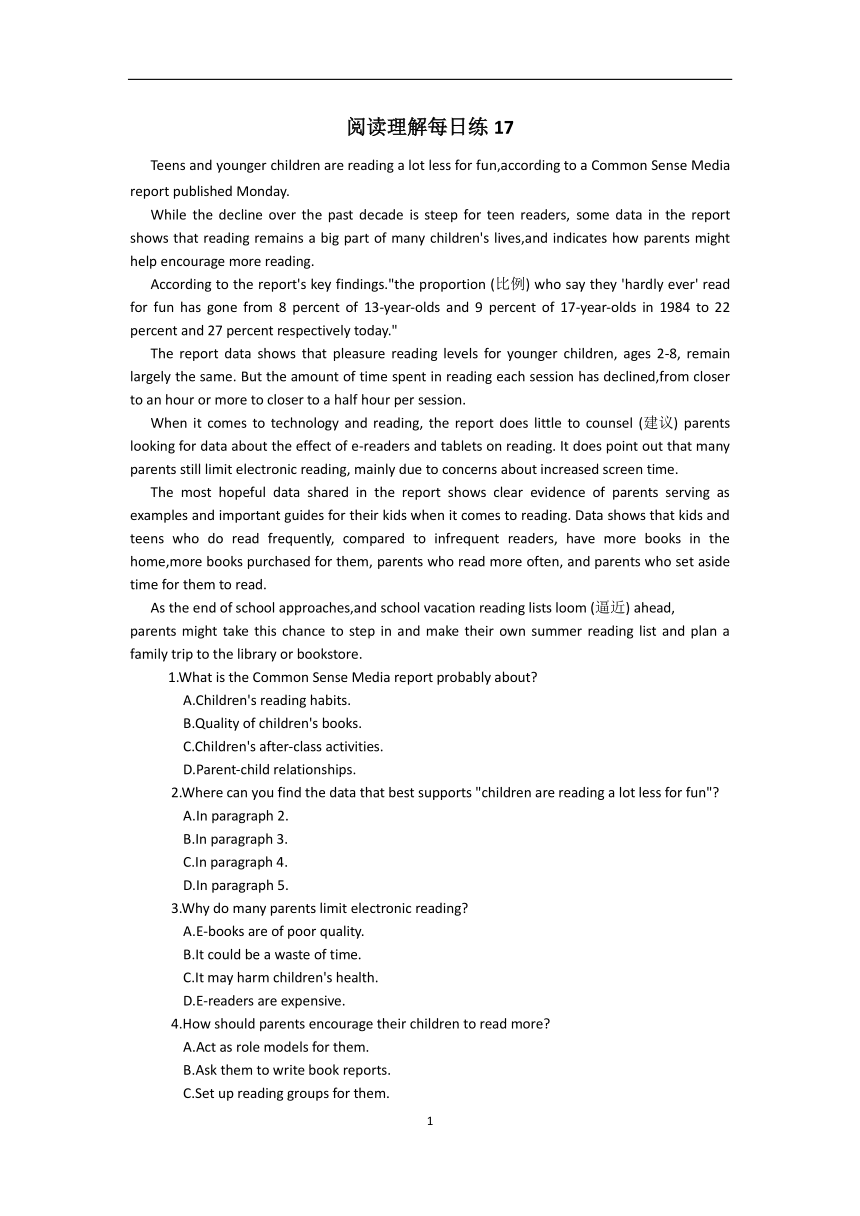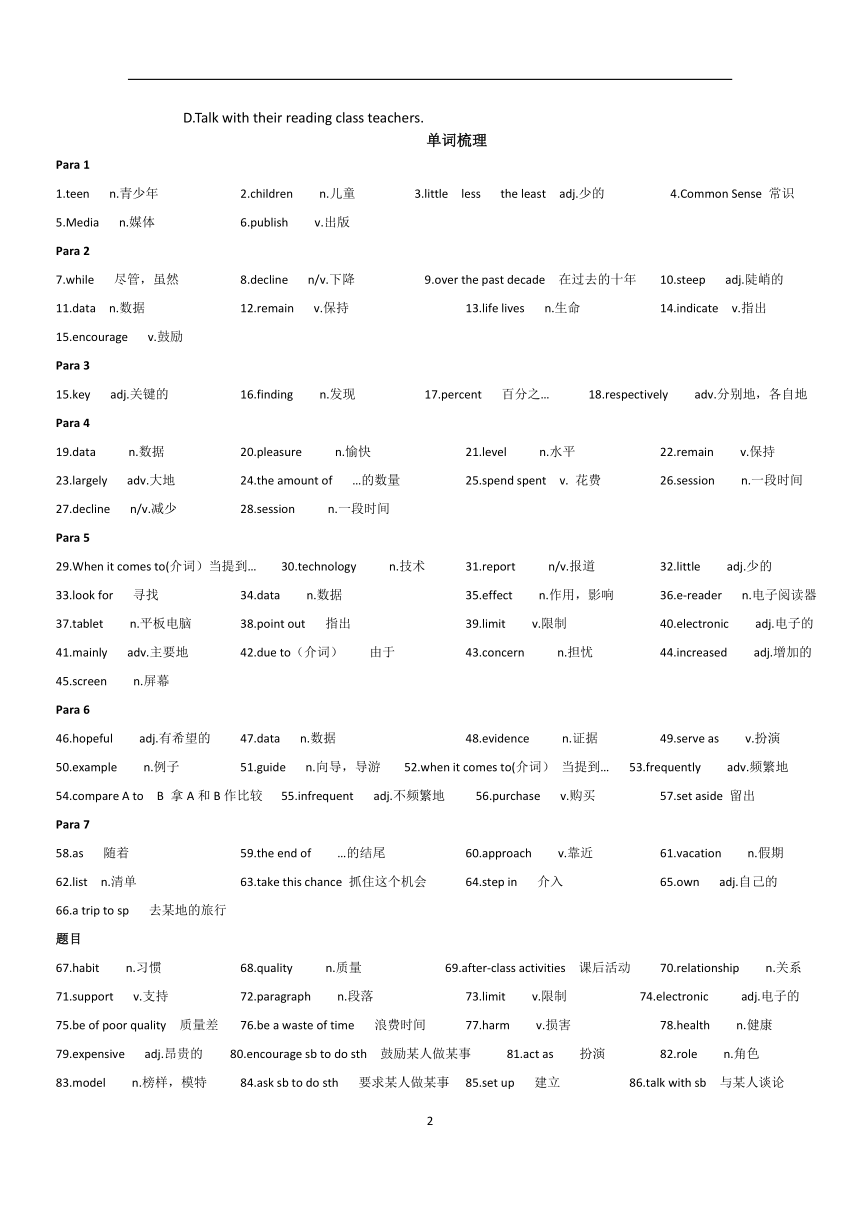2024届高三英语二轮复习阅读 练习导学案(含答案)
文档属性
| 名称 | 2024届高三英语二轮复习阅读 练习导学案(含答案) |  | |
| 格式 | docx | ||
| 文件大小 | 26.3KB | ||
| 资源类型 | 教案 | ||
| 版本资源 | 通用版 | ||
| 科目 | 英语 | ||
| 更新时间 | 2024-03-06 12:31:18 | ||
图片预览


文档简介
阅读理解每日练17
Teens and younger children are reading a lot less for fun,according to a Common Sense Media report published Monday.
While the decline over the past decade is steep for teen readers, some data in the report shows that reading remains a big part of many children's lives,and indicates how parents might help encourage more reading.
According to the report's key findings."the proportion (比例) who say they 'hardly ever' read for fun has gone from 8 percent of 13-year-olds and 9 percent of 17-year-olds in 1984 to 22 percent and 27 percent respectively today."
The report data shows that pleasure reading levels for younger children, ages 2-8, remain largely the same. But the amount of time spent in reading each session has declined,from closer to an hour or more to closer to a half hour per session.
When it comes to technology and reading, the report does little to counsel (建议) parents looking for data about the effect of e-readers and tablets on reading. It does point out that many parents still limit electronic reading, mainly due to concerns about increased screen time.
The most hopeful data shared in the report shows clear evidence of parents serving as examples and important guides for their kids when it comes to reading. Data shows that kids and teens who do read frequently, compared to infrequent readers, have more books in the home,more books purchased for them, parents who read more often, and parents who set aside time for them to read.
As the end of school approaches,and school vacation reading lists loom (逼近) ahead,
parents might take this chance to step in and make their own summer reading list and plan a family trip to the library or bookstore.
1.What is the Common Sense Media report probably about
A.Children's reading habits.
B.Quality of children's books.
C.Children's after-class activities.
D.Parent-child relationships.
2.Where can you find the data that best supports "children are reading a lot less for fun"
A.In paragraph 2.
B.In paragraph 3.
C.In paragraph 4.
D.In paragraph 5.
3.Why do many parents limit electronic reading
A.E-books are of poor quality.
B.It could be a waste of time.
C.It may harm children's health.
D.E-readers are expensive.
4.How should parents encourage their children to read more
A.Act as role models for them.
B.Ask them to write book reports.
C.Set up reading groups for them.
D.Talk with their reading class teachers.
单词梳理
Para 1
1.teen n.青少年 2.children n.儿童 3.little less the least adj.少的 4.Common Sense 常识
5.Media n.媒体 6.publish v.出版
Para 2
7.while 尽管,虽然 8.decline n/v.下降 9.over the past decade 在过去的十年 10.steep adj.陡峭的
11.data n.数据 12.remain v.保持 13.life lives n.生命 14.indicate v.指出
15.encourage v.鼓励
Para 3
15.key adj.关键的 16.finding n.发现 17.percent 百分之… 18.respectively adv.分别地,各自地
Para 4
19.data n.数据 20.pleasure n.愉快 21.level n.水平 22.remain v.保持
23.largely adv.大地 24.the amount of …的数量 25.spend spent v. 花费 26.session n.一段时间
27.decline n/v.减少 28.session n.一段时间
Para 5
29.When it comes to(介词)当提到… 30.technology n.技术 31.report n/v.报道 32.little adj.少的
33.look for 寻找 34.data n.数据 35.effect n.作用,影响 36.e-reader n.电子阅读器
37.tablet n.平板电脑 38.point out 指出 39.limit v.限制 40.electronic adj.电子的
41.mainly adv.主要地 42.due to(介词) 由于 43.concern n.担忧 44.increased adj.增加的
45.screen n.屏幕
Para 6
46.hopeful adj.有希望的 47.data n.数据 48.evidence n.证据 49.serve as v.扮演
50.example n.例子 51.guide n.向导,导游 52.when it comes to(介词) 当提到… 53.frequently adv.频繁地
pare A to B 拿A和B作比较 55.infrequent adj.不频繁地 56.purchase v.购买 57.set aside 留出
Para 7
58.as 随着 59.the end of …的结尾 60.approach v.靠近 61.vacation n.假期
62.list n.清单 63.take this chance 抓住这个机会 64.step in 介入 65.own adj.自己的
66.a trip to sp 去某地的旅行
题目
67.habit n.习惯 68.quality n.质量 69.after-class activities 课后活动 70.relationship n.关系
71.support v.支持 72.paragraph n.段落 73.limit v.限制 74.electronic adj.电子的
75.be of poor quality 质量差 76.be a waste of time 浪费时间 77.harm v.损害 78.health n.健康
79.expensive adj.昂贵的 80.encourage sb to do sth 鼓励某人做某事 81.act as 扮演 82.role n.角色
83.model n.榜样,模特 84.ask sb to do sth 要求某人做某事 85.set up 建立 86.talk with sb 与某人谈论
答案
一.译文
根据周一出版的《常识媒体》报道,青少年和小孩阅读的乐趣越来越少。
虽然青少年读者数量在过去十年中的下降趋势十分明显,但报告中的一些数据显示,阅读仍然是许多儿童生活的重要组成部分,并指出家长如何帮助鼓励孩子更多地阅读。
根据报告的主要研究结果,“‘从来没有享受过阅读乐趣’的青少年的比例,从1984年13岁占比8%和17岁占比9%,变为现在的13岁占比22%和17岁占比27%。”
报告数据显示,2岁至8岁儿童的快乐阅读水平基本保持不变。但是,每次阅读的时间已经减少,从接近一个小时或更多到现在的接近半小时。
当谈到科技和阅读时,报告几乎没有建议父母寻找关于电子阅读器和平板电脑对阅读效果的数据。它指出,许多家长仍然限制电子阅读,主要是担心看屏幕的时间增加。
报告中最鼓舞人的数据清楚地证明,父母在阅读时可以充当他们孩子的榜样和重要指导。数据显示,与不常阅读的人相比,经常阅读的青少年家中有更多的书籍,家庭为他们购买更多书籍,他们的父母也更经常阅读,同时也会留出时间让他们阅读。
随着学期结束,学校的假期阅读清单即将下达,家长可能会借此机会介入并列出自己的暑期阅读清单,并计划全家一起去图书馆或书店。
1.《常识媒体》大概报道了什么?
A.儿童的阅读习惯。 B.儿童书的质量。
C.儿童的课外活动。 D.亲子关系。
2.你在哪里可以找到数据支持“孩子们阅读兴趣大大减少”?
A.在第2段中。 B.在第3段中。
C.在第4段中。 D.在第5段中。
3.为什么很多家长限制电子阅读?
A.电子书质量很差。 B.这可能是浪费时间。
C.它可能会损害儿童的健康。 D.电子阅读器很贵。
4.父母应如何鼓励孩子多读书?
A.作他们的榜样。 B.让他们写读书报告。
C.为他们成立阅读小组。 D.与他们的阅读课老师交谈。
二.解析
1.A 细节题。根据文章第一段中 Teens and younger
children are reading a lot less for fun 可知,Common Sense Media report讨论的是孩子们的阅读习惯。故正确答案为A。
2.B 细节题。文中只有第三段出现了相关数据,论证了孩子阅读习惯的百分比变化。故正确答案为B。
3.C 细节题。根据文章第五段最后一句 It does point out that many parents still limit electronic reading, mainly due to concerns about increased screen time. 可知,家长们因为孩子们看屏幕时间太长而限制电子阅读,所以关心的是孩子们的视力健康问题。故正确答案为C。
4.A 细节题。根据文章第六段第一句 The most hopeful data shared in the report shows clear evidence of parents serving as examples and important guides for their kids when it comes to reading.可知,父母作为阅读榜样和向导至关重要。同时由第六段第二句中 Data shows that kids and teens who do read frequently ···parents who read more often 可知,父母作为榜样多阅读会鼓励孩子们阅读更多。故正确答案为A。
单词梳理
Para 1
1.teen 2.children 3.little less the least 4.Common Sense
5.Media 6.publish
Para 2
7.while 8.decline 9.over the past decade 10.steep
11.data 12.remain 13.life lives 14.indicate
15.encourage
Para 3
15.key 16.finding 17.percent 18.respectively
Para 4
19.data 20.pleasure 21.level 22.remain
23.largely 24.the amount of 25.spend spent 26.session
27.decline 28.session
Para 5
29.When it comes to(介词) 30.technology 31.report 32.little
33.look for 34.data 35.effect 36.e-reader
37.tablet 38.point out 39.limit 40.electronic
41.mainly 42.due to(介词) 43.concern 44.increased
45.screen
Para 6
46.hopeful 47.data 48.evidence 49.serve as
50.example 51.guide 52.when it comes to(介词) 53.frequently
pare A to 55.infrequent 56.purchase 57.set aside
Para 7
58.as 59.the end of 60.approach 61.vacation
62.list 63.take this chance 64.step in 65.own
66.a trip to sp
题目
67.habit 68.quality 69.after-class activities 70.relationship
71.support 72.paragraph 73.limit 74.electronic
75.be of poor quality 76.be a waste of time 77.harm 78.health
79.expensive 80.encourage sb to do sth 81.act as 82.role
83.model 84.ask sb to do sth 85.set up 86.talk with sb
3
Teens and younger children are reading a lot less for fun,according to a Common Sense Media report published Monday.
While the decline over the past decade is steep for teen readers, some data in the report shows that reading remains a big part of many children's lives,and indicates how parents might help encourage more reading.
According to the report's key findings."the proportion (比例) who say they 'hardly ever' read for fun has gone from 8 percent of 13-year-olds and 9 percent of 17-year-olds in 1984 to 22 percent and 27 percent respectively today."
The report data shows that pleasure reading levels for younger children, ages 2-8, remain largely the same. But the amount of time spent in reading each session has declined,from closer to an hour or more to closer to a half hour per session.
When it comes to technology and reading, the report does little to counsel (建议) parents looking for data about the effect of e-readers and tablets on reading. It does point out that many parents still limit electronic reading, mainly due to concerns about increased screen time.
The most hopeful data shared in the report shows clear evidence of parents serving as examples and important guides for their kids when it comes to reading. Data shows that kids and teens who do read frequently, compared to infrequent readers, have more books in the home,more books purchased for them, parents who read more often, and parents who set aside time for them to read.
As the end of school approaches,and school vacation reading lists loom (逼近) ahead,
parents might take this chance to step in and make their own summer reading list and plan a family trip to the library or bookstore.
1.What is the Common Sense Media report probably about
A.Children's reading habits.
B.Quality of children's books.
C.Children's after-class activities.
D.Parent-child relationships.
2.Where can you find the data that best supports "children are reading a lot less for fun"
A.In paragraph 2.
B.In paragraph 3.
C.In paragraph 4.
D.In paragraph 5.
3.Why do many parents limit electronic reading
A.E-books are of poor quality.
B.It could be a waste of time.
C.It may harm children's health.
D.E-readers are expensive.
4.How should parents encourage their children to read more
A.Act as role models for them.
B.Ask them to write book reports.
C.Set up reading groups for them.
D.Talk with their reading class teachers.
单词梳理
Para 1
1.teen n.青少年 2.children n.儿童 3.little less the least adj.少的 4.Common Sense 常识
5.Media n.媒体 6.publish v.出版
Para 2
7.while 尽管,虽然 8.decline n/v.下降 9.over the past decade 在过去的十年 10.steep adj.陡峭的
11.data n.数据 12.remain v.保持 13.life lives n.生命 14.indicate v.指出
15.encourage v.鼓励
Para 3
15.key adj.关键的 16.finding n.发现 17.percent 百分之… 18.respectively adv.分别地,各自地
Para 4
19.data n.数据 20.pleasure n.愉快 21.level n.水平 22.remain v.保持
23.largely adv.大地 24.the amount of …的数量 25.spend spent v. 花费 26.session n.一段时间
27.decline n/v.减少 28.session n.一段时间
Para 5
29.When it comes to(介词)当提到… 30.technology n.技术 31.report n/v.报道 32.little adj.少的
33.look for 寻找 34.data n.数据 35.effect n.作用,影响 36.e-reader n.电子阅读器
37.tablet n.平板电脑 38.point out 指出 39.limit v.限制 40.electronic adj.电子的
41.mainly adv.主要地 42.due to(介词) 由于 43.concern n.担忧 44.increased adj.增加的
45.screen n.屏幕
Para 6
46.hopeful adj.有希望的 47.data n.数据 48.evidence n.证据 49.serve as v.扮演
50.example n.例子 51.guide n.向导,导游 52.when it comes to(介词) 当提到… 53.frequently adv.频繁地
pare A to B 拿A和B作比较 55.infrequent adj.不频繁地 56.purchase v.购买 57.set aside 留出
Para 7
58.as 随着 59.the end of …的结尾 60.approach v.靠近 61.vacation n.假期
62.list n.清单 63.take this chance 抓住这个机会 64.step in 介入 65.own adj.自己的
66.a trip to sp 去某地的旅行
题目
67.habit n.习惯 68.quality n.质量 69.after-class activities 课后活动 70.relationship n.关系
71.support v.支持 72.paragraph n.段落 73.limit v.限制 74.electronic adj.电子的
75.be of poor quality 质量差 76.be a waste of time 浪费时间 77.harm v.损害 78.health n.健康
79.expensive adj.昂贵的 80.encourage sb to do sth 鼓励某人做某事 81.act as 扮演 82.role n.角色
83.model n.榜样,模特 84.ask sb to do sth 要求某人做某事 85.set up 建立 86.talk with sb 与某人谈论
答案
一.译文
根据周一出版的《常识媒体》报道,青少年和小孩阅读的乐趣越来越少。
虽然青少年读者数量在过去十年中的下降趋势十分明显,但报告中的一些数据显示,阅读仍然是许多儿童生活的重要组成部分,并指出家长如何帮助鼓励孩子更多地阅读。
根据报告的主要研究结果,“‘从来没有享受过阅读乐趣’的青少年的比例,从1984年13岁占比8%和17岁占比9%,变为现在的13岁占比22%和17岁占比27%。”
报告数据显示,2岁至8岁儿童的快乐阅读水平基本保持不变。但是,每次阅读的时间已经减少,从接近一个小时或更多到现在的接近半小时。
当谈到科技和阅读时,报告几乎没有建议父母寻找关于电子阅读器和平板电脑对阅读效果的数据。它指出,许多家长仍然限制电子阅读,主要是担心看屏幕的时间增加。
报告中最鼓舞人的数据清楚地证明,父母在阅读时可以充当他们孩子的榜样和重要指导。数据显示,与不常阅读的人相比,经常阅读的青少年家中有更多的书籍,家庭为他们购买更多书籍,他们的父母也更经常阅读,同时也会留出时间让他们阅读。
随着学期结束,学校的假期阅读清单即将下达,家长可能会借此机会介入并列出自己的暑期阅读清单,并计划全家一起去图书馆或书店。
1.《常识媒体》大概报道了什么?
A.儿童的阅读习惯。 B.儿童书的质量。
C.儿童的课外活动。 D.亲子关系。
2.你在哪里可以找到数据支持“孩子们阅读兴趣大大减少”?
A.在第2段中。 B.在第3段中。
C.在第4段中。 D.在第5段中。
3.为什么很多家长限制电子阅读?
A.电子书质量很差。 B.这可能是浪费时间。
C.它可能会损害儿童的健康。 D.电子阅读器很贵。
4.父母应如何鼓励孩子多读书?
A.作他们的榜样。 B.让他们写读书报告。
C.为他们成立阅读小组。 D.与他们的阅读课老师交谈。
二.解析
1.A 细节题。根据文章第一段中 Teens and younger
children are reading a lot less for fun 可知,Common Sense Media report讨论的是孩子们的阅读习惯。故正确答案为A。
2.B 细节题。文中只有第三段出现了相关数据,论证了孩子阅读习惯的百分比变化。故正确答案为B。
3.C 细节题。根据文章第五段最后一句 It does point out that many parents still limit electronic reading, mainly due to concerns about increased screen time. 可知,家长们因为孩子们看屏幕时间太长而限制电子阅读,所以关心的是孩子们的视力健康问题。故正确答案为C。
4.A 细节题。根据文章第六段第一句 The most hopeful data shared in the report shows clear evidence of parents serving as examples and important guides for their kids when it comes to reading.可知,父母作为阅读榜样和向导至关重要。同时由第六段第二句中 Data shows that kids and teens who do read frequently ···parents who read more often 可知,父母作为榜样多阅读会鼓励孩子们阅读更多。故正确答案为A。
单词梳理
Para 1
1.teen 2.children 3.little less the least 4.Common Sense
5.Media 6.publish
Para 2
7.while 8.decline 9.over the past decade 10.steep
11.data 12.remain 13.life lives 14.indicate
15.encourage
Para 3
15.key 16.finding 17.percent 18.respectively
Para 4
19.data 20.pleasure 21.level 22.remain
23.largely 24.the amount of 25.spend spent 26.session
27.decline 28.session
Para 5
29.When it comes to(介词) 30.technology 31.report 32.little
33.look for 34.data 35.effect 36.e-reader
37.tablet 38.point out 39.limit 40.electronic
41.mainly 42.due to(介词) 43.concern 44.increased
45.screen
Para 6
46.hopeful 47.data 48.evidence 49.serve as
50.example 51.guide 52.when it comes to(介词) 53.frequently
pare A to 55.infrequent 56.purchase 57.set aside
Para 7
58.as 59.the end of 60.approach 61.vacation
62.list 63.take this chance 64.step in 65.own
66.a trip to sp
题目
67.habit 68.quality 69.after-class activities 70.relationship
71.support 72.paragraph 73.limit 74.electronic
75.be of poor quality 76.be a waste of time 77.harm 78.health
79.expensive 80.encourage sb to do sth 81.act as 82.role
83.model 84.ask sb to do sth 85.set up 86.talk with sb
3
